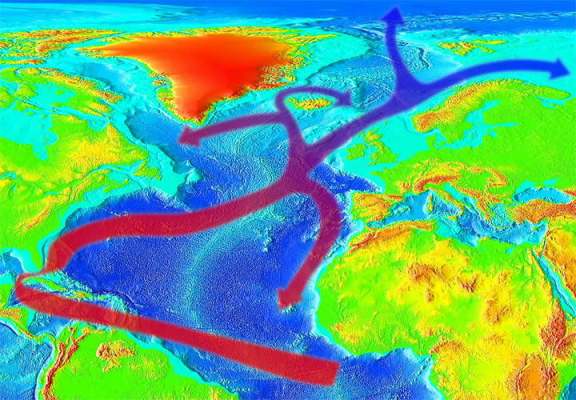Temperatures in Western Europe could fall by 5 to 10 degrees Celsius over the course of the century. While this may sound good in an era of rising temperatures around the world, such a climate event would have devastating consequences for agriculture. As one climate scientist told Inside Climate News, it would be like “trying to grow potatoes in Northern Norway.” According to Slate, other places (such as Norway) will simply become too cold for human habitation.
The Atlantic Meridional Overturning Circulation (AMOC) is an ocean current that brings warm water from the tropics all the way to the Arctic Circle. Scientists have been warning about the collapse of the AMOC for years, but a new study finds that as fresh water is added to the ocean through melting glaciers, the current could face rapid collapse and virtually disappear within a century. This would have catastrophic consequences around the world, but especially in Northern Europe, where the AMOC helps keep impacts fairly moderate compared to similar latitudes around the world.

Compared to North American cities, London is strikingly far north—in fact, it’s further north than any other U.S. city in the Lower 48 state. However, visit London and northern Maine in the dead of winter and you will be shocked at the temperature difference. This incredible temperature contrast is caused by a major ocean current known as the Atlantic Meridional Overturning Circulation, or AMOC.
This current brings heat, carbon and nutrients from the tropics all the way to the Arctic Circle, sweeping the west coast of the British Isles. This current makes many northern European cities much more livable, which is why AMOC is one of the most important components of the world’s climate regulation system. But for the first time in 10,000 years, this system was under threat.
The catastrophic consequences of AMOC’s collapse are well known—so well known that its disappearance served as one of the disastrous plot points of the 2004 film The Day After Tomorrow. While the fallout from AMOC’s collapse is dealt with somewhat in Hollywood, simplifying its life-threatening consequences into a comfortable 90-minute running time, the real-life consequences of AMOC’s demise are no less dire.

Scientists have been tracking the impact of climate change on the AMOC for decades, and previous studies have examined past climate events and identified the tipping point that will likely lead to the end of the AMOC. Now a new study published earlier in the journal Science Advances shows that the situation is even grimmer than previously thought.
“In a new study using the latest generation of Earth climate models, we simulated freshwater flow until ocean circulation reached a tipping point,” the authors write for The Conversation. “The results showed that the current can stop completely within a century of reaching the tipping point, and that it is moving in that direction.”
The main problem is that melting glaciers are pumping too much fresh water into this ocean conveyor belt. This reduces the salinity of the current, which prevents sinking and thus weakens the current as a whole. Once too much fresh water enters the system (the so-called tipping point), AIOC collapse occurs quickly.

So what does the decline of AMOC mean for the world at large? Well, nothing good. While the situation won’t deteriorate as quickly as in The Day After Tomorrow, temperatures in Western Europe could fall by 5 to 10 degrees Celsius over the course of the century. While this may sound good in an era of rising temperatures around the world, such a climate event would have devastating consequences for agriculture. As one climate scientist told Inside Climate News, it would be like “trying to grow potatoes in Northern Norway.” According to Slate, other places (such as Norway) will simply become too cold for human habitation.
While some studies suggest such a collapse could occur as soon as next year, new research casts doubt on that assumption. While they don’t know for sure when this might happen, the team has developed an early warning system of sorts to warn the world when the AMOC approaches the point of no return.
“We were able to develop a physics-based and observable early warning signal involving salinity transport at the southern margin of the Atlantic Ocean,” the authors write. “Once the threshold is reached, the tipping point is likely to be one to four decades away.”




